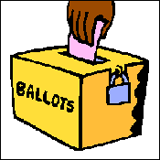
Advocates for voting reform are worried the provincial government's dispute with the electoral boundaries commission will be an excuse to ditch the promised second referendum on switching to a single transferable vote system.
"I know there are people in the legislature who would love to see STV die," said Bruce Hallsor, a lawyer who is president of Fair Voting B.C. "There are people in the government who would love to kibosh the whole thing. This may be their last chance."
The Electoral Boundaries Commission is to report back to the legislature by Feb. 15. If it fails to meet the government's expectations -- and Liberal house leader Mike de Jong said in November the government won't support any recommendation that reduces rural representation -- the house will not adopt the report.
That would mean the boundaries, based on the 1991 census, will stay the same for the 2009 election. While many observers have noted this will leave the election open to legal challenge as too many constituencies will deviate more than 25 per cent from the average, it will also mean there are no STV boundaries to show voters.
A convenient excuse
"My concern is if there aren't any boundaries, that is going to give the government an excuse to say, 'We won't do the referendum,'" Hallsor said. "That's our greatest fear."
Using STV, voters rank the candidates in order of preference, and votes are tallied in a way supporters say greater reflects the electorate's intentions. The system would require fewer, larger constituencies, and each would be represented by more than one MLA.
Most sitting politicians would be thrilled to see the proposal die, Hallsor said. "In general, politicians like first past the post. At least the politicians who get elected under first past the post like it."
Most seats are considered "safe" for one party or the other, he said, making the real races at the party nomination meetings instead of in the elections. Under STV, however, a Liberal in the Fraser Valley, for instance, might find herself running against several other people from the same party. All of a sudden the seat is much less "safe." Said Hallsor, "There's a natural inclination by incumbent politicians not to like a more democratic voting system."
STV voters' choice
The majority of voters, however, prefer STV. In a 2005 referendum, 58 per cent of British Columbians voted to replace the current first past the post system with STV, which had been recommended by a citizens' assembly. That was a clear majority, but short of the 60 per cent the government set as the bar to change the system.
Premier Gordon Campbell, whose Liberal party in the general election held with the referendum got 46 per cent of the votes but formed a majority government, responded to the referendum result by promising a second vote on the issue. It was initially promised to be held with the November 2008 municipal elections, but was later moved to be held with the 2009 provincial vote.
The government also instructed the electoral boundaries commission to draw two sets of constituencies -- one for a first past the post election, and one for an STV election. The commission included both sets in its preliminary report.
"It may help us to have a map," said Hallsor. During the last campaign some people said they wanted to know what the constituencies would look like before they could support STV, he said. On the other hand, he added, no doubt some people will dislike the map. "There's going to be somewhere in the province a crappy looking boundary."
Border skirmish
It was, however, the commission's suggestions for first past the post boundaries that drew fire. The commission recommended eliminating three seats in the north and the Kootenays, and adding five ridings in the Lower Mainland and Okanagan. It increased the total number of constituencies in the province from the current 79 to 81.
Following public outcry, and NDP opposition, the Liberal government refused to accept the commission's recommendations and brought forward legislation requiring the commission to set 87 constituencies, but failed to pass that legislation in November.
The commission had begun drawing boundaries for the 87 constituencies, said executive director Leo Perra, but ditched that work when the legislation died. It then took its preliminary report for public hearings and will bring a final submission to the legislature by February 15. "As far as the commission's concerned, it's their final report," said Perra.
The commissioners are in the final stages of completing the report, he said, adding it will be based on the original instructions to the commission, which allow a maximum of 85 seats.
If the referendum will go ahead, Hallsor said, there should be some indication in the throne speech and budget of how much funding there will be for 'no' and 'yes' campaigns. In 2005 the campaigns were not funded, but Campbell has promised they will be this time.
"We'll be watching it closely," said Hallsor. "We'll know in a couple weeks."
Related Tyee stories:
I'll gladly take on opponents, because the way we vote now produces bizarre results.
STV got a bigger vote than the 2001 Liberals. Now what?
STV was a dud, but we need more women in government
Read more: Rights + Justice, Politics















Tyee Commenting Guidelines
Comments that violate guidelines risk being deleted, and violations may result in a temporary or permanent user ban. Maintain the spirit of good conversation to stay in the discussion.
*Please note The Tyee is not a forum for spreading misinformation about COVID-19, denying its existence or minimizing its risk to public health.
Do:
Do not: